By Dalia Pratali Maffei
Postdoctoral researcher, Ghent University
The special form and function of religious languages
Have you ever thought that speaking to the supernatural permeates our everyday life? Prayers, words of thanks, and blasphemies are heard and performed across the world every day. These speech acts are part of what we can call ‘religious language’, which can be defined as a language used in a specific context of communication, to talk about or to the supernatural (Darquennes & Vandenbussche 2011: 1).
In many cultures across the world, religious languages tend to be distant from everyday speech, as an indication of a moment that is also perceived as distant from everyday trivial activities. For instance, the ritual language of the Sumbanese in Indonesia is in poetic form and uses metaphors not immediately understood (Mitchell 1988). Dignity and authority are often obtained also through language no longer in use in everyday situations. For instance, we can think of Classical Arabic, used as language of the Quran to this day, while other varieties of Arabic spread in the vernacular; or Latin, used as language of the Catholic Church until 1965, well after Romance languages developed; or the conservative and archaic English grammar and vocabulary (e.g. thou for you, speakest for speak) used for translations of the Bible (Crystal & Davy 1969); or Old Slavonic, still used in Eastern and Orthodox and Catholic Churches (Willi 2003: 11-13). In these last cases mentioned, we should not forget the importance of Church institutions in the preservation and promotion of these varieties (Ferguson 1986). It is also relevant that these religious languages did not happen overnight: their formulaic and conservative character was regularised through time and with usage, and the contrast with vernaculars spoken in everyday situations—which inevitably change—increased with time.
The case of Ancient Greek dedications
In Ancient Greece in the Hellenistic age (end of 4th – 1st c. BC) we can also observe the development of a language variety used in religious contexts, which was poetic and conservative at the same time, combining the two aspects mentioned above. This language variety can be observed in a specific type of document: inscriptions written on dedications, i.e. objects presented to deities in religious contexts, mainly to ask or to thank for a specific favour, or to gain the mercy of the deity (Guarducci 1967: 121; Licciardello 2022: 13). Usually, these objects were made of durable material such as stone and were altars or statues of gods. A dedication could say something like Αὔτα[νδ]ρο[ςκαὶ] Μῦς̣ τὸν βομὸν ⋮ ℎιε̣ρ[ὸν ἀνέθέ]θεν το͂ι Ποσειδο͂νι τὸν θράνιν ℎελόντε, Autandros and Mys dedicated the sacred altar to Poseidon, after they caught a swordfish (SEG 16-19, Eleusis, 5th c. BC). Here, two fishermen thank the god for an excellent catch: these documents are fascinating because they can offer a unique perspective on the everyday wishes and struggles of Ancient peoples.
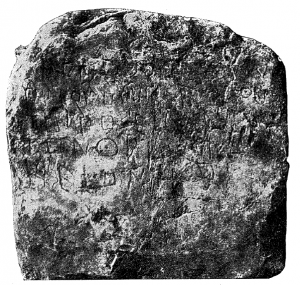
What was the language used in these dedications? The first inscriptions we have are from the 8th century BC, and during the Archaic and Classical ages (8th – end of 4th c. BC) some of them attest an interesting combination of elements. First, they were written in poetry, i.e. in verses that followed a specific metrical pattern (mainly hexameters), which provided a certain distance from everyday vernacular, as we saw above. The second interesting element was their dialect: it was a time when Ancient Greek did not consist of one single standard variety, but of many dialects spoken in different areas, each with different grammar features and vocabulary; different dialects were also used in different literary genres, such as Epic, Tragedy, Comedy, etc. So, the peculiarity of these verse dedications is that their dialect was made up of a mixture of forms from the dialect of Homer, i.e. of Epic poems, and of the local dialects spoken where the dedications were set up. So, even if these inscriptions were usually written for everyday and concrete matters, both their poetic form and their unusual dialectal mixture gave them an unusual character (Mickey 1981). At the same time, we cannot really talk about a specific religious language at this time, because metrical inscriptions with this dialectal mixture were also used in different circumstances, e.g. for funerary monuments.
In the following centuries and specifically in the Hellenistic Age (end of 4th – 1st c. BC), local dialects gradually disappeared, replaced by a new variety used across Greece as lingua franca, the Koine. Therefore, we might expect these dialects to disappear also from our verse inscriptions: on the contrary, local dialects kept being used, especially in the case of dedications! Even if, again, it is hard to talk of a specific ‘religious language’, the presence of local dialects in verse dedications more than in other inscriptions was likely due, at least partly, to the fact that religious languages tend to be more conservative. Let us look at this peculiar example from Cyrene, a town in Egyptian Lybia.
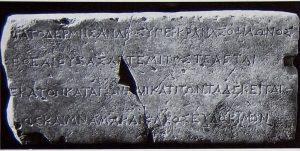
Μνᾶμα τόδ᾿ Ἑρμήσανδρος ὑπὲρ κράνας ὁ Φίλωνος
θῆκε θεᾶι θύσας Ἀρτέμιτος τελετᾶι
βοῦς ἑκατὸν κατάγων καὶ ἴκατι· τῶν τάδε κεῖται
κόσμος καὶ μνάμα καὶ κλέος εὐδόκιμον.
This monument Hermesandros son of Philon dedicated above the fountain (or spring?), once he had sacrificed to the goddess, after leading down (into the sanctuary) for Artemis’ festival hundred and twenty oxes. Of them these (words) remain as ornament and keepsake and glorious fame.
This inscription (GVCyr 23, https://igcyr.unibo.it/gvcyr023) witnesses that a private citizen, probably quite wealthy, dedicated at the sanctuary of Apollon 120 (!!!) oxen, in a public occasion, likely to obtain the favour of the gods as well as the citizens. Most striking is that in the dedication, the poet uses elements of the local dialect (Dobias-Lalou 2020: 207), which was being replaced by the Koine (ᾱ for Koine η in words such as Μνᾶμα; ἴκατι, ‘twenty’, for Koine εἴκοσι; and the god name Ἀρτέμιτος for Ἀρτέμιδος).
An “institutionalised” religious linguistic variety?
While verse dedications seem to hold a conservative dialect across Greece, in Sparta we find one specific sanctuary where dedications showed not just conservative but archaic forms, i.e. forms that had already disappeared—as far as we know—from the dialect, and were used only in that specific context. This was the sanctuary of Artemis Orthia: the archaising dialect of inscriptions was likely favoured by the ancient character of the cult, set up in 700 BC, and by the institutionalisation and continuity of its ritual practices—I mentioned above that often the role of religious institutions was vital to standardise and promote religious languages. It is even more striking to think that the dialect kept being used in the imperial age (1st – 4th c. AD), which implies that religious practices had a role in the preservation of linguistic diversity, as it also happens today. These inscriptions are so peculiar that scholars still debate whether their dialect was artificial, and used exclusively with a religious function, or whether it was still spoken in the rural surroundings (cf. e.g. Alonso Déniz 2014; Kristoffersen 2019). Here is an example of a dedication dated to the 4th – 3rd c. BC (edition in CEG II 821).
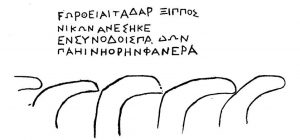
Ϝωρθείαι τάδ’ Ἀρ[ή]ξιππος νικῶν ἀνέσηκε
ἐν συνόδοις πα[ί]δων πᾶhιν hορῆν φανερά.
Arexippus, the victor, dedicated this to (Artemis) Orthia at the festivals of young boys, visible for all to see.
Here, a victor from local festivals performed at the sanctuary and dedicated a monument to the local goddess, Arthemis Orthia, to thank her for the victory. The dialect of the inscription is local (e.g. ᾱ for Koine η, η for Koine ᾱ in hορῆν), and we find some forms not attested in contemporary prose inscriptions from Sparta, including the name of the goddess herself (Ϝωρθείαι is written with Ϝ, digamma, a letter that indicated the sound /w/; we also have σ for Koine θ in ἀνέσηκε and h for σ in πᾶhιν). This language likely produced a solemn effect, which was also achieved through other elements: the alphabet shows letters no longer in use after the 4th c. BC, such as <Ϝ>, digamma, and <h> to represent an aspirated sound (rather than η). We should assume, anyway, that even if the dialect and the alphabet of these inscriptions was archaic, it was still understood by the devotees and the passers-by. At the same time, we can imagine that it was not always easy to find a balance «between the ordinary and the obscure» (Crystal & Davy 1969), between clear communication and marked language.
Go big or go home
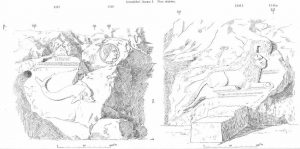
This last example showed how each dedication and context is worth studying on its own: this is especially true in the case of exceptions to the rule, i.e. where we do not find a conservative or archaic language variety. Indeed, we are reminded that «in fixed texts, even the smaller variation might bear social significance» (Ferguson 1986: 210). I am talking about a very peculiar rock. Now we move to the old acropolis of Santorini: at its southern entrance, we find an uneven rock with sixteen verse dedications and several reliefs, all commissioned by the same person, Artemidoros, a Ptolemaic official. This is one of the highest numbers of dedications by the same individual ever recorded in antiquity. They did not simply serve a religious function but were set in a public space and aimed at showing the important role of Artemidoros in the island. Hence, we might not be surprised that they were written not in the local dialect but in Koine (with some poetic dialectal features). Koine was a variety of prestige, to be used in formal situations, and it better represented the political power of Artemidorus, since it was the variety used by the Ptolemaic reign (Pratali Maffei 2023: 207-208).
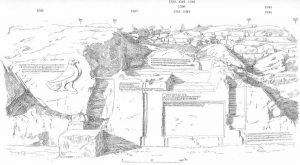
Right side of Artemidoros’ wall, facsimile, from IG XII,3,suppl.
Beyond verse dedications
These examples showed that verse dedications can teach us much about society in Ancient Greece: not only what people longed for, but also what their relationship with gods was and how they tried to communicate with them. One important lesson we learned is that religious practices contributed to the preservation of language varieties and linguistic diversity and that we have many examples of it in today’s world. Clearly, verse dedications are only a tiny fragment of religious practices: we have dedications in prose, curses on lead tablets, and even the so-called ‘magical papyri’ and confessionary inscriptions from late antiquity. With the emergence of online databases collecting a vast range of documents, such as the EVWRIT database, we have easier access to these documents. This means that their comparative analysis can lead us to a wider, holistic understanding of society and language usages in Ancient Greece, and, in return, can enlighten us on everyday life.
Abbreviations
IG = Inscriptiones Graecae (1873– ).
CEG = Hansen, P.A. (1983–9). Carmina Epigraphica Graeca, 2 vols., Berlin.
SEG = Supplementum epigraphicum Graecum (1923– ).
GVCyr = Dobias-Lalou, C. (2017). Greek Verse Inscriptions of Cyrenaica, in collaboration with A. Bencivenni, with help from J. M. Reynolds and C. Roueché, Bologna, CRR-MM.
Bibliography
Alonso Déniz, A. (2014). ‘L’esprit du temps: koiné, dialecte et hyperdialecte dans les inscriptions agonistiques du sanctuaire d’Artémis Orthia à Sparte’, in S. Minon (éd.), Diffusion de l’Attique et expansion des koinai dans le Péloponnèse et en Grèce centrale, Genève, 141-168.
Crystal, D., & Davy, D. (1969). Investigating English Style. London.
Darquennes, J., & Vandenbussche, W. (2011). ‘Language and Religion as a Sociolinguistic Field of Study. Some Introductory Notes’, Sociolinguistica, 25(1), 1-11.
Dobias-Lalou, C. (2020). ‘Langue poétique et formes dialectales dans les inscriptions versifiées grecques: le cas de la Cyrénaïque’, Revue de philologie, de littérature et d’histoire anciennes 92(2), 189-212.
Ferguson, C.A. (1986). ‘The Study of Religious Discourse’, in D. Tannen and J. E. Alatis (eds.), Languages and Linguistics. The Interdependence of Theory, Data, and Application, Washington DC, 205-13.
Guarducci, M. (1967–1978). Epigrafia Greca, voll. 1-4, Roma.
Kristoffersen, T.R. (2019). ‘The Artemis Orthia Inscriptions and Spoken Laconian in the Imperial Period. In Defence of Dialect Survival at Sparta’, Glotta 95, 169-189.
Licciardello, F. (2022). Deixis and Frames of Reference in Hellenistic Dedicatory Epigrams, Berlin – Boston.
Mickey, K. (1981). ‘Dialect Consciousness and Literary Language. An Example from Ancient Greek’, TPhS 79(1), 35-66.
Mitchell, D. (1988). ‘Method in the Metaphor. The Ritual Language of Wanukaka’, in J. J. Fox (ed.), To Speak in Pairs, Essays on the Ritual Languages of Eastern Indonesia, Cambridge, 64-86.
Pratali Maffei, D. (2023). The Dialect of Hellenistic Inscribed Epigrams from Doric-Speaking Areas, PhD Thesis, University of Cambridge.
Sawyer, J.F., Simpson, J.M.Y., & Asher, R.E. (2001). Concise Encyclopedia of Language and Religion, Elsevier.
Willi, A. (2003). The languages of Aristophanes. Aspects of Linguistic Variation in Classical Attic Greek, Oxford.